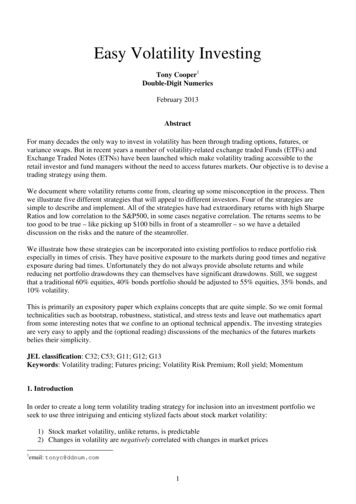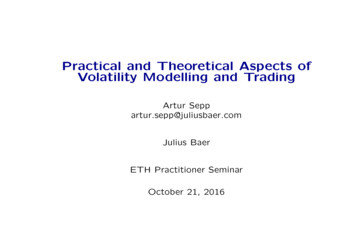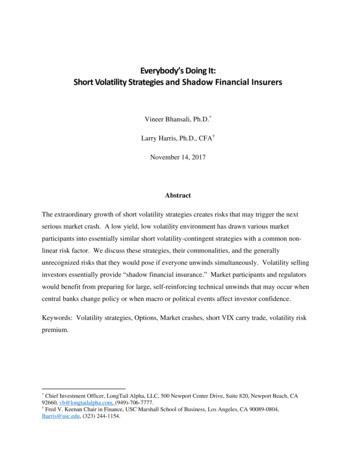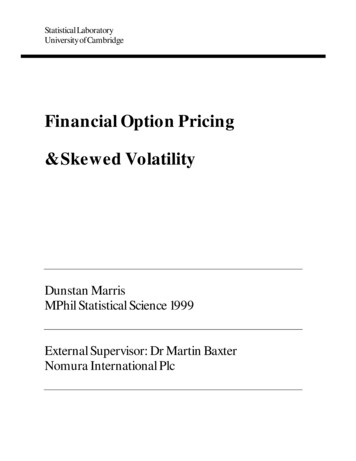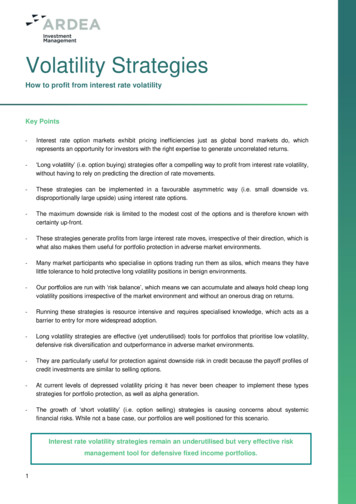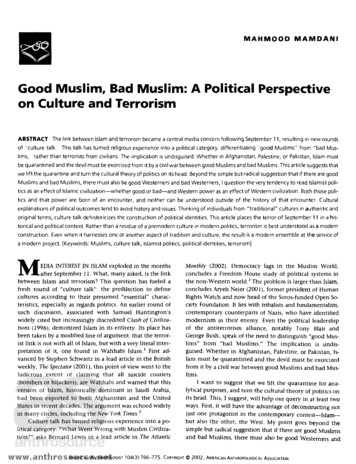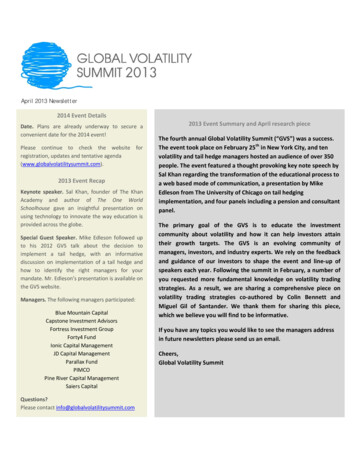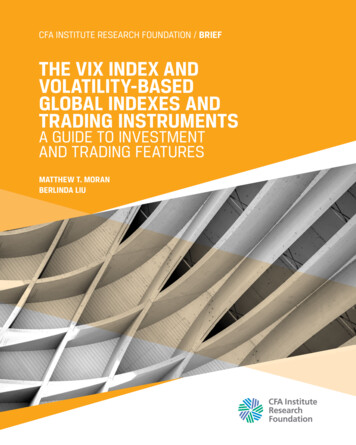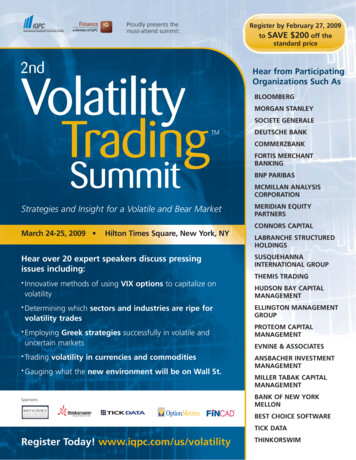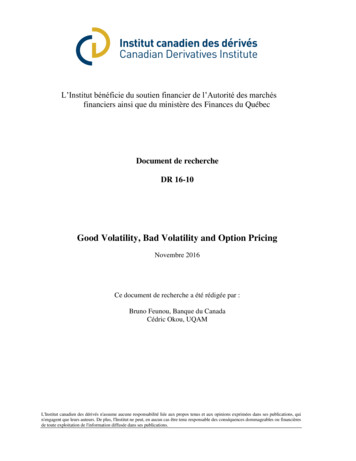
Transcription
L’Institut bénéficie du soutien financier de l’Autorité des marchésfinanciers ainsi que du ministère des Finances du QuébecDocument de rechercheDR 16-10Good Volatility, Bad Volatility and Option PricingNovembre 2016Ce document de recherche a été rédigée par :Bruno Feunou, Banque du CanadaCédric Okou, UQAML'Institut canadien des dérivés n'assume aucune responsabilité liée aux propos tenus et aux opinions exprimées dans ses publications, quin'engagent que leurs auteurs. De plus, l'Institut ne peut, en aucun cas être tenu responsable des conséquences dommageables ou financièresde toute exploitation de l'information diffusée dans ses publications.
Good Volatility, Bad Volatility and Option Pricing Bruno FeunouFinancial Markets DepartmentBank of CanadaCédric OkouESGUQAMNovember 30, 2016AbstractAdvances in variance analysis permit to split the total quadratic variation of a jump-diffusionprocess into upside and downside components, commonly referred to as good and bad volatilities. This decomposition yields enhanced volatility predictions over standard approaches, asdocumented by many recent studies. To appraise the economic gain of the decomposition, we design a new and flexible option pricing model in which the underlying asset price exhibits distinctupside and downside semi-variances driven by their model-free empirical proxies and randominnovations. This discrete-time option valuation framework outperforms common benchmarkmodels in terms of fitting accuracy and likelihood improvements. The model also delivers realistic term structures of risk-neutral moments and variance risk premia.JEL Classification: G12Keywords: Dynamic Upside Volatility, Dynamic Downside Volatility, Dynamic Skewness,Realized Downside Volatility, Realized Upside Volatility. Please address correspondence to Bruno Feunou, who can be reached by phone at 613-782-8302 or by email atfeun@bankofcanada.ca. Cédric Okou is at okou.cedric@uqam.ca. We gratefully acknowledge financial support fromthe Bank of Canada, UQAM research funds, and the IFSID. We are indebted to Peter Christoffersen, Diego Amaya,Christian Dorion, and Yoontae Jeong for helpful discussions. The views expressed in this paper are those of theauthors. No responsibility for them should be attributed to the Bank of Canada.
1IntroductionThe proper specification of the underlying asset volatility dynamics is a key input for designinga successful option valuation framework. Volatility randomness, persistent memory pattern, andsubstantial conditional tail thickness of the underlying distribution are a few empirical regularitiesoften accounted for in valuation models to accurately fit the observed option prices. Heston andNandi (2000), Bates (2000), Duffie, Pan, and Singleton (2000), and Huang and Wu (2004), amongothers, have made far-reaching contributions in this regard. Moreover, the asymmetric volatilityresponse to positive versus negative shocks is a well-established stylised fact.Building on these insights, this paper develops an option valuation model in which the underlying asset price features specific upside and downside variance dynamics. In our modelingframework, good and bad volatilities are factors governing the return process, and evolve accordingto their nonparametric realized measures. The theoretical and empirical justifications for constructing reliable realized variance measures using high frequency observations are addressed inseminal papers by Andersen et al. (2001a), Andersen et al. (2001b), and Andersen et al. (2003), tocite a few. Drawing on similar “infill asymptotics” arguments, Barndorff-Nielsen, Kinnebrock, andShephard (2010) show, in a model-free way, how to dissect the realized variance in terms of upsideand downside semi-variances obtained by summing high frequency positive and negative squaredreturns, respectively. This decomposition has been used to improve realized variance forecasts(Patton and Sheppard, 2015), or predict the equity risk premium given the standard risk-returntradeoff (Guo, Wang, and Zhou, 2015). Our option pricing framework extends these studies byhelping gauge the economic value-added of disentangling the upside semi-variance motion from itsdownside counterpart.This article is related to a large body of the finance literature that aims at building optionpricing models with empirically grounded properties. A brief review of the various developmentsin the valuation of option contracts is provided by Chernov et al. (2003). A few studies proposeto model the joint dynamics of returns and realized variances in the context of option pricing.This class of option valuation models is shown to deliver superior pricing performance comparedto models optimized only on returns. Recent developments include papers by Stentoft (2008),Corsi, Fusari, and Vecchia (2013), Christoffersen et al. (2014), and Christoffersen, Feunou, and1
Jeon (2015).The aforementioned papers focus exclusively on the total realized variation, or its diffusiveand jump components, but do not incorporate the information pertaining to the direction of thevariation. To the best of our knowledge, our framework is the first that explicitly prices optionswith distinct dynamics for observable upside and downside realized variations. By modeling thedirectional variations, our model successfully accounts for the asymmetry in the distribution ofof the underlying asset. Moreover, the model is affine and cast in discrete time, which permitscomputing explicit pricing formulas, and entails a straightforward fitting procedure.The contribution of this work is not, however, limited to constructing a novel option pricingframework. We also formally describe the major factors driving market compensations of goodversus bad uncertainty. We take the model to data and show that the newly proposed specificationperforms well in matching the historical as well as the risk-neutral distributions. Namely, the modelimproves significantly upon popular specifications with respect to several performance criteria,when optimized on a data set of S&P 500 index options, realized upside and downside variances,and returns. We find that the conditional asymmetry in our specification matters for deliveringempirically grounded term structures of risk-neutral moments as well as market premia for upsideand downside risks. Allowing for distinct up/down variance dynamics in our pricing model is usefulto track the time variation in the variance risk premium and its components at different horizons.The paper is organized as follows. In Section 2 we present the theoretical and empirical arguments underpinning the construction and the use of good/bad (upside/downside) variation measures. Section 3 introduces a novel option pricing model that is general enough to accommodatespecific upside and downside variance dynamics in the underlying return process, while drawingrelevant information from their empirical proxies. In Section 4, we describe the physical estimationstrategy and discuss the different specifications that our option pricing framework encompasses.We also discuss the estimation findings based on historical observations. Section 5 investigates theempirical ability of the various nested models to fit the risk-neutral distribution embedded in optioncontracts. We implement a joint optimization procedure that combines historical information andoption data in Section 6. In addition, we study the empirical performance of our pricing kernel anddocument the determinants of variance risk premium components. Section 7 concludes.2
2Daily Returns and Realized Variation MeasuresIn this section, we outline the arguments supporting the decomposition of the total quadraticvariation into its upside and downside components. Disentangling the upside realized semi-variationfrom its downside counterpart can be achieved by exploiting the fine structure of high frequencyobservations. For instance, empirical measures of daily realized good (resp. bad) volatility areoften constructed from intraday records exceeding (resp. falling below) a specified threshold.2.1Separating downside from upside volatility: EmpiricsFor our empirical analysis, we download intraday S&P500 cash index data from TickData.com.On a given day, we use the last record in each one-minute interval to build a grid of one-minuteequity index values from which we compute five series of overlapping five minute log-returns. Thisallows us to compute five realized variance measures from the sum of squared five-minute returnsfor each observation day in our sample. Following Andersen et al. (2003, 2001a), we constructP t 22 is thethe realized variance of returns on any given trading day t as RVt nj 1rj,t , where rj,tj th intraday squared log-return and nt is the number of intraday returns recorded on that day.We add the squared overnight log-return (the difference in log price between when the marketopens at t and when it closes at t 1), and we scale the RVt series to ensure that the sampleaverage realized variance equals the sample variance of daily log-returns. For a given thresholdκ 0, we decompose the realized variance into upside and downside realized variances followingBarndorff-Nielsen, Kinnebrock, and Shephard (2010):RVtU ntX2rj,tI[rj,t 0] ,j 1RVtD ntX2rj,tI[rj,t 0] .j 1We add the squared overnight “positive” log-return (exceeding the threshold κ 0) to theupside realized variance RVtU , and the squared overnight “negative” log-return (falling below thethreshold κ 0) to the downside realized variance RVtD . Because the daily realized variance sums3
the upside and the downside realized variances, we apply the same scale to the two components ofthe realized variance. Specifically, we multiply both components by the ratio of the sample varianceof daily log-returns over the sample average of the (pre-scaled) realized variance.By construction, the cumulative realized variance adds up the cumulative realized upside anddownside variances:RVt RVtU RVtD .2.2(1)Separating downside from upside volatility: TheoryWe briefly review the key theoretical results that allow us to separate daily positive from negativequadratic variation using intraday data. We mainly rely on Barndorff-Nielsen, Kinnebrock, andShephard (2010), who assume that the stock price follows a jump-diffusion of the formdst µt dt σt dWt st ,where dWt is an increment of standard Brownian motion and st st st refers to the jumpcomponent. The instantaneous variance can be defined as σet2 σt2 ( st )2 . Under this generalassumption on the instantaneous return process, Barndorff-Nielsen, Kinnebrock, and Shephard(2010) use infill asymptotics – convergence as the time separating two consecutive observationscollapses to 0 – to prove thatURVt 1p pDRVt 1 12Z12Zt 1συ2 dυ tX( sυ )2 I[ sυ 0] ,t υ t 1t 1συ2 dυ tX( sυ )2 I[ sυ 0] .t υ t 1This decomposition of the realized variance into its up and down components is used by Pattonand Sheppard (2015) to study the information content and the predictive ability of signed squaredjumps.Moreover, the difference between realized upside and downside variance can be perceived asa measure of (realized) skewness. This measure of asymmetry, denoted as RSVt , is computed by4
subtracting the downside semi-variance from the upside semi-variance:UDRSVt 1 RVt 1 RVt 1.Thus, if RSVt 1 0 the distribution is left-skewed and when RSVt 1 0 it is right-skewed.A theoretical justification for using RSVt 1 as a measure of skewness can be found in Feunou,Jahan-Parvar, and Tédongap (2014). To provide more intuition on the behavior of RSVt 1 , wecombine the previous asymptotic results to getpRSVt 1 X ( sυ )2 I[ sυ 0] I[ sυ 0] .t υ t 1Assuming that jump sizes are i.i.d. and uncorrelated with the jump occurrence, the expectationof the realized skewness – a measure of the conditional skewness – ishiEPt [RSVt 1 ] EP ( s)2X(P[ sυ 0] P[ sυ 0]) .t υ t 1Thus, EPt [RSVt 1 ] captures – up to a multiplicative constant – the wedge between positive andnegative jump intensities. Put differently, this realized skewness measure shows, in relative terms,how likely positive jumps are with respect to negative jumps. The realizations of directional jumpsreceive different weights according their sizes, consistent with the volatility jump risk study of Bandiand Renò (2015). Obviously, bigger weights are assigned to larger jump sizes in the computationof RSVt 1 .2.3Empirical dynamics of downside and upside volatilitiesFigure 1 plots the daily time series of the return on S&P 500 index (Graph A), along with thesquare root of the daily realized variance (Graph C), the square root of its upside (Graph B) andthe square root of its downside (Graph D) components from January 02, 1990 to April 26, 2013.Periods of market instability, characterized by large swings in returns and a high level of volatility,are clearly apparent. These turbulent periods include the recent financial market meltdown of 20082009, the early 2000s, and the early 1990s. By contrast, the mid 1990s and the mid 2000s periods5
exhibit low levels of volatility. The time series of the realized variance and its components displaya good level of synchronicity, as they tend to rise and fall around the same periods. The differencebetween (square roots) of upside and downside variance (Graph E), which is an alternative measureof asymmetry, appears to be time varying with important fluctuations during the 2008 financialcrisis period.Consistent with established empirical regularities, realized variance RVt series exhibit markedlyhigher persistence, dispersion, positive asymmetry and heavy-tailness, as compared to returns distribution. Moreover, we see that RVtU and RVtD have similar magnitudes. This observation issupported by the nearly identical average values of RVtU and RVtD presented in Table 1, alongwith other common summary statistics. Sizeable discrepancies between these two time series canarise from risk-neutral (rather than historical) expectations extracted from option data, as documented in Feunou, Jahan-Parvar, and Okou (2015). Using a similar logic as Bollerslev, Tauchen,and Zhou (2009), dynamic “variance-of-(semi-)variance” processes are needed to generate premiafor second-order semi-moments. Specifically, the realized downside variance measure requires a dynamic specification of its own, one that is likely different from the dynamic specification of upsidevariation. Building a dynamic return model with such features is our next task.3A New Dynamic Model for Asset ReturnsThis section builds a model for option valuation that incorporates the information in Rt , RVtU , andRVtD , computed at the end of any given day t. In our model, state variables are explicitly filteredfrom our observable quantities. In addition, we focus on an empirical strategy for option pricingthat can be implemented without resorting to Monte Carlo simulations.3.1The asset return processConsider the following specification for daily log returnsRt 1 r̄ (λu ξu ) hu,t (λd ξd ) hd,t zu,t 1 zd,t 1 ,6(2)
where the innovations, zu,t 1 and zd,t 1 , distinctly and respectively represent positive and negativeshocks to the return dynamics.1 These innovations are modeled aszj,t 1 z̃j,t 1 Et [z̃j,t 1 ] , for j {u, d},where the underlying shocks z̃j,t 1 have a positive support, namely, z̃j,t 1 0 for j {u, d}.This specification ensures that the return shocks, zu,t 1 and zd,t 1 , are conditionally demeaned.We further assume that the volatilities of returns shocks are time varying and driven by the statevariables hu,t and hd,t . Thus, the following equalities hold:V art [zu,t 1 ] V art [z̃u,t 1 ] hu,t ,V art [zd,t 1 ] V art [z̃d,t 1 ] hd,t .We therefore interpret hu,t and hd,t as good and bad stock market volatilities, that is, volatilitiesstemming from the right and left tail movements in stock returns.To get closed-form expressions for equilibrium asset prices, we consider a return shock distribution for which the log moment-generating function is linear in the underlying variances hu,t andhd,t . Namely,ln Et [eνzj,t 1 ] aj (ν) bj (ν) hj,t ,where the functions aj (ν) and bj (ν) capture the shape of the moment-generating function of theunderlying return shocks. Compound Poisson and Gamma laws are prominent examples of suchdistributions. Bekaert and Engstrom (2015) use a difference of demeaned Gamma shocks to studyasset return dynamics in a “bad environment-good environment” framework. For this class ofdistributions, the function aj (ν) and bj (ν) are non-negative, convex, and asymmetric. That is,aj (ν) aj ( ν) and bj (ν) bj ( ν) for ν 0. In this paper, we opt for the Noncentral chi-squareddistribution, which has been widely used in the discrete time option pricing literature (See Heston1In our timing convention, hj,t for j {u, d} stands for the conditional semi-variance for day t 1 computed atthe end of day t.7
and Nandi (2000)). Thus, we cast the underlying shocks to return asrz̃j,t 1 ωj2s(1)εj,t 1 hj,t ωj2ωj!2(1)iid, with εj,t 1 N (0, 1) for j {u, d},withhi(1)(1)E εu,t 1 εd,t 1 0.One can easily check that the corresponding aj (ν) and bj (ν) functions areν2 ,p2 1 2ωj νrp ωj1aj (ν) ωj bj (ν) ln 1 2ωj ν ,22bj (ν) (3)and that by construction, we havehj,t V art [zj,t 1 ] .By setting ωj 0 in functions aj (ν) and bj (ν), it is apparent thatzj,t 1Distribution ωj 0N (0, hj,t ) .Thus, the parameter ωj drives the non-normalities, a property which is useful when modelingdaily stock return series. To further analyze the sources of potential departure from normality, wecompute the conditional skewness 3/2htSkewt [Rt 1 ] 2h i 3/23 ωu (hu,t hd,t ) 3 ( ωu ωd ) hd,t ωu3/2 ωd,whereht hu,t hd,tis the total conditional variance of returns. Two sources of non-normality emerge, that is, thedifference between upside and downside variance hu,t hd,t , and the discrepancy between non normalities in good and bad shock distributions ωu ωd . An interesting case is obtained byimposing ωu ωd . This constraint implies that the wedge between the upside and downside volatil-8
ity, hu,t hd,t , offers a unique channel for inducing conditional skewness in the return dynamics.3.2Incorporating realized upside and downside variationEach day, realized upside and downside variations provide new information about the semi-variances,U and RV D are measured with error, and therefore, we specify thehu,t and hd,t . However, RVt 1t 1following measurement equationjRVt 1 hj,t σj (2)εj,t 1 2p γj hj,t ωj 1 γj2 (hj,t ωj ) for j {u, d}.(4)The measurement error variables introduced in the realized semi-variances dynamics,(2)iidεj,t 1 N (0, 1) for j {u, d},feature the following correlation structurehi(2)(2)E εu,t 1 εd,t 1 0,hi(1)(2)E εj,t 1 εj,t 1 ρj ,(1)where the εj,t 1 s denote the return shocks.The innovation term inside the brackets in equation (4) is constructed to have zero mean,ensuring thatihjEt RVt 1 hj,t .(2)jNote also that equation (4) allows for a nonlinear impact of εj,t 1 on RVt 1via γj .3.3Upside and downside volatility dynamicsWe are now ready to specify the dynamics of the expected upside and downside realized variances.We assume the following recursive dynamics, where new information on realized downside (orupside) variance at time t 1 is used to update our t 2 forecast of realized downside (or upside)variances. jhj,t 1 ωj ω̃j β̃j (hj,t ωj ) α̃j RVt 1 ωj .9(5)
This is very similar to GARCH models, with the exception that less noisy measures are used toupdate conditional variances. This specification simply implies that hu,t 1 and hd,t 1 are bothU and RV D belong to the class of univariate ARM A(1, 1)univariate AR(1) processes. Thus, RVt 1t 1processes. Using equation (4), equation (5) can be rewritten as 2 p(2)hj,t 1 ωj j βj (hj,t ωj ) αj εj,t 1 γj hj,t ωj ,(6)whereω̃j j αj ,β̃j βj γj2 αj α̃j αj,σjαj.σjEquation (6) is very similar to the conditional variance dynamics in Heston and Nandi (2000).(2)The only difference here is that the Gaussian shock εj,t 1 is not perfectly correlated to returns.We will refer to this general specification as the generalized skew affine realized variance (GSARV)model.3.4Expected returns and risk premiumsEquation (2) clearly entails that the one-day-ahead conditionally expected log returns in the modelis simplyEt [Rt 1 ] r̄ (λu ξu ) hu,t (λd ξd ) hd,t .The coefficients ξu , ξd and r̄, are functionally dependent on the deep parameters of the model, asfollows"# ωu 2ωu ωd 2ωd1 , r̄ rf ln 1 2ωu ln 1 2ωd 21 2ωu1 2ωdξu 2 1 1 2ωu , ξd 1 , 2 1 2ωd10(7)(8)
where rf denotes the risk-free rate. These functional forms ensure that the conditionally expectedtotal return isEt [exp (Rt 1 )] exp (rf λu hu,t λd hd,t ) ,(9)which in turn allows to interpret λu and λd as compensations for upside and downside volatilitiesexposures, respectively. Substituting equation (2) into (9), taking expectations, and solving forξu , ξd and r̄ yields equations (7) and (8). Therefore, the parameters ξu , ξd and r̄ are not estimatedbelow, but instead, simply set to their values implied by the identities in equations (7) and (8).3.5Conditional second momentsFrom the model above, it is relatively straightforward to derive the following one-day-ahead conditional second momentsV art [Rt 1 ]ihjV art RVt 1 UCovt Rt 1 , RVt 1 DCovt Rt 1 , RVt 1 UDCovt RVt 1, RVt 1 hu,t hd,t(10) 2σj2 1 2γj2 (hj,t ωj ) 2ωu σu ρ2u 2 (hu,t ωu ) γu σu ρu 2ωd σd ρ2d 2 (hd,t ωd ) γd σd ρd 0.Note that the model allows for two types of “leverage” effects: One via the return covariance withupside variation and another via the return covariance with downside variation.4Physical EstimationUp to here, we have laid out a general framework for incorporating upside and downside realizedvariations when modeling the underlying asset dynamics. In this section we develop a likelihoodbased method that enables us to estimate the physical parameters using daily observations onreturns, as well as the good and bad realized variation measures. We also discuss five special casesof the general specification that includes the Heston and Nandi (2000) benchmark GARCH model.11
4.1Deriving the likelihood functionIn deriving the conditional quasi-likelihood function, we compute the contribution of the day t 1observation vector by multiplying the marginal densities with a Gaussian copula. Formally, we canwriteUDft Rt 1 , RVt 1, RVt 1 UD fr,t (Rt 1 ) fU,t RVt 1fD,t RVt 1 UD ct Fr,t (Rt 1 ) , FU,t RVt 1, FD,t RVt 1, U , and fDwhere fr,t (Rt 1 ), fU,t RVt 1D,t RVt 1 are the marginal conditional densities of returns, U , andupside and downside realized variance, respectively. Accordingly, Fr,t (Rt 1 ), FU,t RVt 1 DFD,t RVt 1are the marginal conditional cumulative distribution function of returns, upside anddownside realized variance, while ct (ν, νU , νD ) denotes the density of the Gaussian copula. To characterize the randomness surrounding realized upside and downside variance measures, we employgaussian densities and cumulative distribution functions. Thus, jfj,t RVt 1 2j hj,t )(RVt 1exp j2V art [RVt 1]ri ,hj2πV art RVt 1 j RVt 1 hj,t j rFj,t RVt 1 Φ i , for j {u, d},h jV art RVt 1hijwhere Φ(.) is the cumulative distribution function of a standard normal, and the V art RVt 1s aregiven in equation (10). Because we want to highlight the importance of hu,t hd,t in generating nonnormalities in the conditional distribution of returns, we need the exact marginal density function.Notice that the exact marginal density of returns, fr,t (Rt 1 ), is a convolution of two Noncentral chisquared densities, which does not have known closed-form expression. Nonetheless, the conditional12
characteristic function of Rt 1 is available in closed-form as ϕr,t (ν) Et eiνRt 1 iν (r̄ (λu ξu ) hu,t (λd ξd ) hd,t ) exp au (iν) bu (iν) hu,t ad ( iν) bd ( iν) hd,t , where functions aj (ν) and bj (ν) are given in equation (3), and i stands for the imaginary unit.Thus, we exploit Fourier inversion formulas to compute the quantities of interestFr,t (Rt 1 ) fr,t (Rt 1 ) Z1 1 Im e iνRt 1 ϕr,t (ν) dν,2 π 0νZ 1Re e iνRt 1 ϕr,t (ν) dν.π 0Moreover, the copula function is computed as ν 1 ct (ν, νU , νD ) pexp (ν, νU , νD ) CMt 1 I3 νU ,2 CMt νD1 U , RV Dwhere CMt is the conditional correlation matrix of Rt 1 , RVt 1t 1 given by 1 UCMt ρt ρDtwithρUt10ρDt 0 , 1 jCovt Rt 1 , RVt 1ρjt rhi , for j {u, d},jV art [Rt 1 ] V art RVt 1 hijjand where Covt Rt 1 , RVt 1, V art [Rt 1 ], and V art RVt 1are defined in Equation (10).13
Finally, the log-likelihood is calculated asln LP T 1XUDln ft Rt 1 , RVt 1, RVt 1 .(11)t 14.2Nested specificationsBefore turning to the estimation, we discuss five special cases of interest that are nested by thenew option pricing model. Below, these restricted specifications are estimated along with the fullmodel.4.2.1The constrained generalized skew affine realized variance (CGSARV) modelOne of the key objectives of this paper is to highlight the importance of the difference betweenupside and downside variances (hu,t hd,t ) in generating the observed conditional skewness inreturns and to assess the pricing implications. As shown above, the conditional skewness in theGSARV stems from two wedges, ωu ωd and hu,t hd,t . Hence, we consider a special case wherethe first channel is shut down (i.e ω ωu ωd ), thus defining hu,t hd,t as the unique driver ofthe conditional skewness. We refer to this special case as the constrained generalized skew affinerealized variance (CGSARV) model.4.2.2Two factors affine realized variance (GARV) modelAn alternative modeling choice is to conceive upside and downside variances as volatility components that play no role in the conditional skewness. By imposing ωu ωd 0, we get Rt 11 rf λu 2 1hu,t λd hd,t zu,t 1 zd,t 1 ,2withzj,t 1 (1)(1)p(1)hj,t εj,t 1 ,(1)where εj,t 1 are i.i.d. N (0, 1), and εu,t 1 and εd,t 1 are conditionally independent.14
Starting with hj,0 , we have p 2(2)hj,t 1 j βj hj,t αj εj,t γj hj,t , p 2 (2)2RVj,t 1 hj,t σj εj,t 1 γj hj,t 1 γj hj,t ,withhi(1)(2)E εj,t 1 εj,t 1 ρj ,(2)(2)and where εu,t 1 and εd,t 1 are conditionally independent random pairs.Clearly, the GARV model is a particular case of the CGSARV, with the additional constraintω 0.4.2.3The Skew affine realized variance (SARV) modelBy setting hd,t 0 and ωd 0, we have a single factor specificationRt 1 r̄ (λ ξ) ht zt 1 ,zt 1 ηt 1pht ηt 1 , !2 r rω (1)ht ωht ω , εt 1 2ht2ω2ω(1)where the εt 1 s are i.i.d. N (0, 1).Starting with h0 ω, we have 2p(2)ht 1 ω β (ht ω) α εt 1 γ ht ω , 2p (2)2RVt 1 ht σ εt 1 γ ht ω 1 γ (ht ω) ,wherehi(1) (2)E εt 1 εt 1 ρ,15
"# 1ω 2ω ,r̄ rf ln 1 2ω 21 2ω1 .ξ 2 1 2ωThe ARV of Christoffersen et al. (2014) is a special case of the SARV, obtained by letting ω 0.This model also bears close resemblance to the skew GARCH model in Christoffersen, Heston, andJacobs (2006) with two notable differences: (i) we use realized variance to update the conditionalvariance and (ii) to model the departure from non-normality, we rely on the non-central chi-squaredistribution instead of the inverse gamma distribution.4.2.4The affine realized variance (ARV) modelIf we fix hu,t hd,t in the GARV specification, we obtain Rt 11 rf λ 2 ht zt 1 ,withzt 1 p (1)ht εt 1 ,(1)where εt 1 are i.i.d. N (0, 1).Beginning with h0 , we have p 2(2)ht 1 βht α εt 1 γ ht , p 2 (2)2RVt 1 ht σ εt 1 γ ht 1 γ ht ,wherehi(1) (2)E εt 1 εt 1 ρ.This specification is identical to the affine realized variance model in Christoffersen et al. (2014).4.2.5The Heston and Nandi (2000) GARCH modelCanonical GARCH-type option pricing models are obtained by setting ρ 1 in the ARV model.(1)(2)Specifically, ρ 1 implies that εt 1 εt 1 , and therefore, the realized variance motion becomes16
irrelevant. We then get p 2(2)ht 1 βht α εt 1 γ ht p 2(1) βht α εt 1 γ ht ,which is precisely the Heston and Nandi (2000) affine GARCH (1,1) model.4.3Parameter estimates and model propertiesMaximum likelihood estimation results from historical data are given in Table 2. As outlined above,the estimated values are the empirical proxies of the parameters governing the return processesunder the physical distribution. A few remarks are in order regarding the estimation procedure.The parameters are inferred by targeting the unconditional sample variance, and therefore, theydo not have standard errors. Moreover, for two-factor models, we estimate the downside marketprice λd , then back out its upside counterpart λu by exactly matching the observed average excessreturns. Thus, we report the standard errors for the estimates of λd but not for λu .In all six model specifications, the estimates of γu and γd are positive and statistically significant,thus pointing to the so-called leverage effect in the returns dynamics. Moreover, the persistence inthe conditional variance process is much lower for the GARCH model, as compared to the otherspecifications that exhibit variance persistence levels above 0.98.The likelihood values allow us to appraise the performance of the alternative specifications underconsideration. However, a straightforward comparison of likelihoods among these models cannotbe performed because the GARCH model is only fitted to returns, whereas the ARV and SARVmodels are fitted to returns and RV , and the two-factor models are fitted to returns, RVu , and RVd .We see in the bottom panel of Table 2 that the log likelihoods of single factor models are roughlyhalf (one-sixth in the case of the GARCH model) of that of th
Keywords: Dynamic Upside Volatility, Dynamic Downside Volatility, Dynamic Skewness, Realized Downside Volatility, Realized Upside Volatility. Please address correspondence to Bruno Feunou, who can be reached by phone at 613-782-8302 or by email at feun@bankofcanada.ca. C edric Okou is at okou.cedric@uqam.ca.
